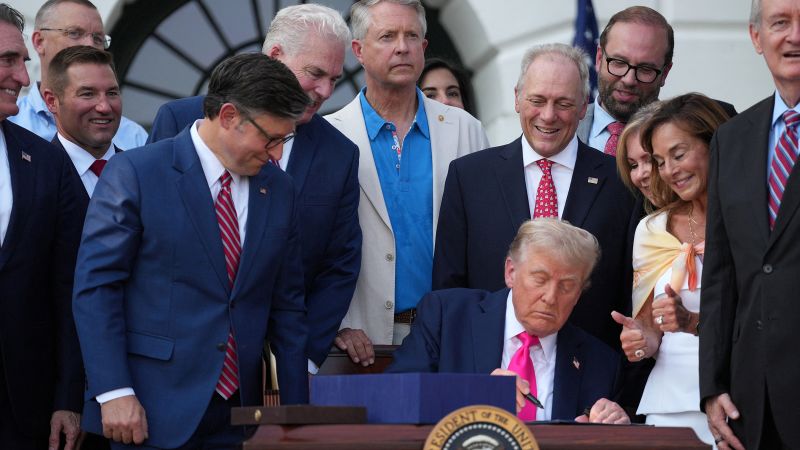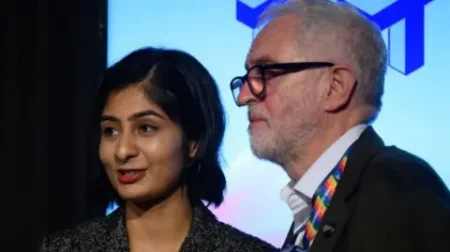On Friday afternoon, President Donald Trump held a celebratory event on the South Lawn of the White House to mark a significant legislative victory, having signed a domestic mega-bill into law after weeks of negotiations with Republican lawmakers. This event was infused with patriotism, celebrating not only the nation’s Independence Day but also his success in Congress. As part of the festivities, a bomber jet flyover paid tribute to recent military actions, particularly strikes on Iranian nuclear facilities, and a fireworks display on the National Mall was also scheduled to conclude the events of the day.
During the event, President Trump proclaimed, “We made promises, and it’s really promises made, promises kept, and we’ve kept them,” while he stood next to First Lady Melania Trump. He emphasized the significance of signing the bill on July 4, the day that marks America’s declaration of independence, drawing parallels between this moment and the triumph of democracy. He had previously set an ambitious goal for the bill’s approval by the holiday, despite doubts from even some of his allies about whether such a timeline was feasible. However, due to Trump’s firm control over his party and an intense campaign to rally Republican support, the House approved the bill with minimal opposition.
The signing event highlighted Trump’s efforts leading up to this legislative victory. He welcomed members of Congress and military families, reinforcing the notion that this legislation was a monumental milestone, claiming it to be “the biggest bill of its type in history.” Nevertheless, the task ahead involved convincing the American public of the bill’s benefits, as many polls suggested skepticism regarding its provisions.
The bill itself proposes an extension of tax cuts originally established in 2017, alongside new tax incentives, culminating in a substantial price tag of $4.5 trillion. Additionally, it allocates increased funding for immigration enforcement and military spending. However, to finance these new expenditures while facing a downturn in tax revenue, the measure proposed a $1 trillion cut to Medicaid as well as reductions in food assistance programs. Although its proponents touted its potential economic advantages, the Congressional Budget Office projected that it would ultimately add $3.3 trillion to the federal deficit, excluding the costs of servicing the accrued debt.
Republicans expressed concerns that the bill’s cuts to critical social safety net programs could jeopardize their standing ahead of the upcoming midterm elections. Analyses indicated that around 12 million Americans might lose health insurance due to the proposed changes, with some estimates suggesting higher figures based on the added paperwork requirements for benefit eligibility.
As expected, Democrats swiftly criticized the bill, highlighting the disproportionate tax benefits it granted to wealthy individuals. They accused Trump of undermining assistance for the impoverished in favor of his affluent supporters. Acknowledging this criticism, some of Trump’s allies recognized the need for an improved narrative surrounding the bill, focusing on its merits while pushing back against negative portrayals.
Despite these challenges, Trump remained optimistic, asserting that Americans would eventually come to recognize the bill’s advantages. He dismissed Democratic claims as a “con job,” maintaining that the signing event celebrated the most popular legislation ever enacted in the nation’s history, despite existing poll data indicating widespread disapproval among the electorate.
Reflecting on history, Trump is aware of predecessors who lamented their lack of sufficient outreach to rally public support for their legislative triumphs, as internal party dynamics faced reelection consequences. For Trump, the bill represents more than a political strategy; it bears personal significance as a reflection of his campaign commitments. He portrays it as a substantial accomplishment that frames the first two years of his administration as a remarkable period in presidential history.
The backdrop of the event included a B-2 bomber flyover, an emblem of recent military decisions, alongside notable political victories — securing commitments from NATO allies on defense spending, a Supreme Court ruling in favor of expanding executive authority, and progress toward a ceasefire in Gaza. As Trump relished these achievements, he concluded his two-week stretch on a high note, expressing satisfaction over his successes.
During the public signing, Trump acknowledged several congressional figures, including House Speaker Mike Johnson and Senate Majority Leader John Thune, for their contributions to passing the legislation. In a symbolic gesture, Johnson presented Trump with the gavel used to conclude the House vote, prompting a moment of engagement before Trump enthusiastically slammed it down, marking the conclusion of a momentous legislative journey.
As the signing event wrapped up, there was a palpable sense of achievement. Trump underscored this success with a resolute commitment to advance the conversation about the bill and seek public validation of its impact moving forward.











